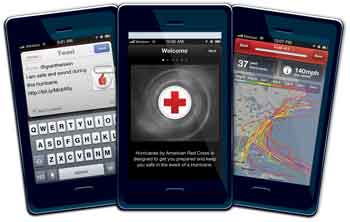 Humanitarian
Humanitarian
American Red Cross
"Disaster Preparedness,"
American Red Cross (Local)
The American Red Cross found that there is a disconnect between Americans’ perceptions of their preparedness and actual preparedness for a disaster; though 85% say that it is very important to be prepared for a long term disaster by having the necessary supplies. When compared to Red Cross’s definition of being prepared – get a kit, make a plan, stay informed – only 10% of people actually are fully prepared. Of the 39% who have a kit, only 44% have updated it within the past 6 months. People don’t prepare in advance because they feel there are too many steps or believe “it won’t happen to me.” In 2012 Hurricane Sandy disproved the latter. For the former – people come to the Red Cross.org when disaster occurs as they saw with disasters like the earthquake in Hati or Japan’s tsunami. For those who seek Red Cross advice on how to prepare, the American Red Cross has various 8 ½ x 14 “tearsheets” with approximately 30 steps that need to be taken in order to be ready for the nexst emergency available. However, most disaster types require more than one sheet. For example, to be fully prepared for a hurricane, the average person would need all of the following Red Cross “tearsheets”: Hurricane, Flood, Power outage, Food spoilage, Generator safety, Be Red Cross Ready, and Evacuation. This results in the average person being intimidated and simply not taking any steps at all. So the American Red Cross came up with the following conclusions: they needed to provide a complete preparedness solution, they needed to provide content in an easily digestible manner, they needed to be able to update that content in real time and they needed to be the destination people went to for information. There are a variety of apps currently available that focus on one of the following – generic preparedness info, mobile donations, weather information, social media and flashlights. However, the Red Cross Preparedness Apps contain all of the above in an effort to provide a complete preparedness solution. They have also made improvements on 2 main components – content organization and the weather alerts. While many apps deliver push notifications informing the user that bad weather is coming, The American Red Cross takes it to the next level by not only telling the user bad weather is afoot while also telling them what they need to do now is prepare. While other apps simply contain a scrolling list of everything they need to do during a certain phase of an emergency/disaster event, they have prioritized their content. When the user looks to see what they need to do right after an earthquake, the headings indicate the level of priority, with the “If you do nothing else…” denoting the most important steps, followed by “Then if you can, do this…”, closing with “If you’ve done all that, do this…”. The goal of presenting the content in this fashion was to provide measures to take in bit-sized bits so users would be more likely to do and improve their safety. Including secondary content when relevant the Red Cross tied-in secondary effects of a disaster into the core content. For example, along with a hurricane comes floods, power outages, and food spoilage. With earthquakes, fires can occur as a result of gas leaks caused by the quakes. Thus, this secondary but related content is included throughout the app in each phase, but also presented as a “Related Link” with wording such as “If you’re experiencing flooding” Because of the technical implementation approach of the apps they were able to add specific content as the situation required in real-time. For example, in Sandy’s aftermath, the Red Cross added the following links to the app: FEMA disaster recovery centers, NYC warming station locations, Exxon/Hess gas stations’ status in the NY/NJ area and gasbuddy.com. In the aftermath of the Oklahoma tornadoes, they included links to vetted home/ride share sites, local authorities’ Twitter feeds, as well as FEMA centers. Further enhancing this capability is the ability to target any content added on a state-level. American Red Cross apps encourage social sharing via Facebook, Twitter, text or email throughout, branded as coming from the Red Cross app and include ‘I’m Safe Messages’ these are configurable messages that can be sent via any social channels in order to quickly and easily let loved ones know you’re safe. And because they’ve created apps for specific disasters, any society can replicate this model and adapt for their own by simply adding in their own localized content and including any alerts from a centralized alerting source. It’s a perfectly scalable model, adaptable for any region in the world. The Red Cross’ digital campaign has been extremely successful with over 3.4 million downloads in a 13 month time frame, multiple “New & Noteworthy” and “What’s Hot” features in the Apple store and the Hurricane app reaching #2 of ALL free apps in the App Store during Hurricane Sandy. They have an Average of 4.5/5.0 stars across Android and iPhone platforms. The American Red Cross were winners at the 2013 National Hurricane Conference taking the award for ‘Outstanding Achievement for Hurricane App’
